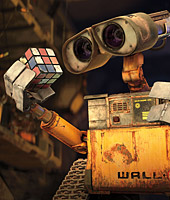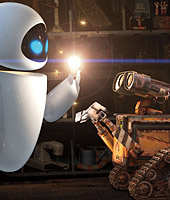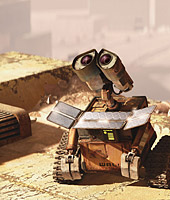Hello WALL·E !
Pixar storyteller Andrew Stanton tells Response about his new film,
and the power of storytelling.
Return to Response OnScreen Archive
 Who would have believed that a mechanical trash compactor would become the most lovable big-screen personality of the year? Who would have believed that a mechanical trash compactor would become the most lovable big-screen personality of the year?
It’s happening. The moviemaking wizards at Pixar Animation Studio are winning raves for WALL·E from kids and critics alike, thanks to a little robot with a big heart. Yes, it’s business as usual for these storytellers and animators who have given moviegoers memorable, awe-inspiring scenes for more than a decade.
With 1995’s Toy Story, Pixar introduced us to a new era in feature-length, digitally animated movies. But they weren’t just showing off. They were concerned about storytelling, developed memorable characters, and gave us a delightful, nostalgic celebration of childlike imagination.
The 1999 sequel, Toy Story 2, Buzz Lightyear and Woody took digital animation to new heights, and the tale found poignant moments that captured the bittersweet struggle to maintain childlike faith as we mature.
In Finding Nemo (2003), they took us snorkeling for 90 minutes in an environment of such colorful, dreamy imagery that moviegoers felt hypnotized. The film’s “focus on the family” thrilled kids and brought tears to the eyes of many parents as well.
The Incredibles (2004) reaffirmed Pixar’s commitment to telling stories that celebrate family relationships, and it was celebrated by superhero fans as one of the best superhero movies ever made.
Others — A Bug’s Life; Monsters, Inc.; and Cars — have won praise from kids and critics alike, and Pixar’s desk-lamp logo has become a stamp of quality and delight for moviegoers of all ages.
With the release of WALL·E, Pixar’s most ambitious and controversial feature, many are wondering if the studio can maintain its “perfect record.” The overwhelming consensus among critics is a hearty “Yes, they can!”
WALL·E is a science fiction fable about the last robot on earth, a lonely little trash compactor who putters through grand canyons of trash, slowly cleaning up an uninhabited world, which humanity polluted and abandoned 700 years earlier. (“WALL·E” stands for “Waste Allocation Load Lifter Earth-Class.”)
WALL·E speaks in a vocabulary of blips provided by sound effects master Ben Burtt, the man who gave R2D2 a voice more than thirty years ago. And yet, while WALL·E’s not speaking English, it’s easy to translate his lonely thoughts. And he doesn’t just smash stuff. He pauses first to ponder the purpose (and sometimes, the absurdity) of every product on this planet-sized landfill. From “sporks” to Rubik’s cubes to lighters to diamond rings, he experiments with his discoveries, providing some of the most delightfully comical entertainment this side of Charlie Chaplin.
In the little trailer he calls home, WALL·E watches battered old VHS tapes of Gene Kelly musicals and savors the spark of human creativity that remains in the rubble. And when two lovers hold hands in Hello Dolly!, something in the robot’s heart lights up like E.T.’s did more than twenty years ago. Despite the desperate practicality of his design, there is a longing in WALL·E that tells him he’s meant for something greater. The poor little droid — a cross between Short Circuit’s “Number Five” and the Energizer Bunny — is desperately lonely, having only a perky cockroach as a friend. When you’ve sunk so low, where can you look but up?
 With WALL·E, Pixar has expanded the range of its power impressively. The film is full of clever nods to Star Wars, E.T. The Extra-Terrestrial, 2001: A Space Odyssey, and even Blade Runner. Nevertheless, WALL·E is anything but derivative. It’s original, groundbreaking science fiction, and a satire with edges so sharp they’d impress Jonathan Swift. With WALL·E, Pixar has expanded the range of its power impressively. The film is full of clever nods to Star Wars, E.T. The Extra-Terrestrial, 2001: A Space Odyssey, and even Blade Runner. Nevertheless, WALL·E is anything but derivative. It’s original, groundbreaking science fiction, and a satire with edges so sharp they’d impress Jonathan Swift.
Don’t let reviews spoil the details, but WALL·E may find his chance at true love. He’s also drawn into an adventure that resembles the story of Noah’s Ark, as he learns what became of humankind, and as he marvels at the grace of a dove-like robot called EVE. Just as there is hope for that lonely, rusty droid to find salvation from his trash-strewn existence, so there is hope for that lonely, polluted planet — that sad little sphere puttering along its orbit, groaning for all that it has become, and all that it was meant to be.
It’s almost enough to make a moviegoer think that the storyteller, Andrew Stanton (who also wrote Finding Nemo), has Christian convictions of his own. Recently interviewed for Christianity Today by Mark Moring, Stanton spoke openly about his faith.
Speaking to Response, Stanton spoke about writing stories that can make a difference. (And, much to this interviewer’s astonishment, revealed that he had read my book Through a Screen Darkly as he was working on WALL·E!)
Stanton also took time to address some concerns that critics have raised about the film’s satirical turns. Some have complained that the film mocks consumer culture, and that its portrayal of humanity’s “evolution” into a race of infantile, obese couch potatoes is grossly cynical.
But Stanton doesn’t feel that way at all. For him, it was a story that grew in the telling, as J.R.R. Tolkien once said of The Hobbit… a story that began with a very lonely character.
A Chat With Andrew Stanton
Response: I know I’m not the only one who’s been charmed by the teasers and trailers for WALL•E. But I was not prepared for this film. It caught me by surprise. You really took the audience out of the Pixar “comfort zone,” so to speak, and into some new territory — a vision of the future that was saddening and bleak.
Stanton: Well … it’s sci-fi. I don’t know any great sci-fi movies that aren’t bleak in their backdrop. The initial conceit that I had in 1994 was “the last robot on earth” — just that sentence — and there’s just nothing optimistic about that sentence.
And yet, in a weird way, I think that backdrop of bleakness is a major factor in why you like WALL•E. He’s this light that shines in the middle of all this sort of gloom.
Response: To tell that kind of story on a platform the size of Pixar’s seems risky. As a storyteller, you’re looking for what will reach our minds and hearts. But most movie producers, on the other hand, are focused on the bottom line. This movie was more thoughtful and grim than most summer entertainment. It was a gamble. Did anybody push back, or get uncomfortable, at any point along the way, when they saw where you wanted that little robot to lead us?
 Stanton: I am so proud to say, Nope! That’s what’s wonderful about Pixar. It’s an artist that runs the studio, and Steve Jobs is practically an artist himself in a CEO’s clothing. They completely saw how great of a film this could be if done right. And the only question was, Can we pull it off? Do we have enough chops and enough know-how after all these years to do something that would be more challenging to execute? Nobody was put off by it. They were all engaged by it. Stanton: I am so proud to say, Nope! That’s what’s wonderful about Pixar. It’s an artist that runs the studio, and Steve Jobs is practically an artist himself in a CEO’s clothing. They completely saw how great of a film this could be if done right. And the only question was, Can we pull it off? Do we have enough chops and enough know-how after all these years to do something that would be more challenging to execute? Nobody was put off by it. They were all engaged by it.
Response: There’s some debate online as to whether WALL•E is one giant contradiction … whether it’s fair for Disney, the great empire of merchandising, to put out a movie that asks if we’ve gone too far in answering our consumer impulses.
Stanton: I do think it’s a cautionary tale about taking anything too far. I wasn’t necessarily pushing “anti-consumerism,” I was just pushing against something that has gone to an extreme.
It’s fine if it brings a little bit of conscience to a large corporation, even if it’s us.
I know that [people at Disney] have tried to be a little bit more “green-friendly,” and it’s made them more conscientious in the making of a lot of this stuff over the duration of it. But again, I’m not wagging fingers.
To be honest, I reverse-engineered the whole idea. My first idea was, like I said before, “the last robot on earth.” I knew I wanted him to be a trash robot because that would allow him to be able to go through the evidence of humanity, and be able to convey that without having to use dialogue. Trash is very visual. I was raised in the ‘70s, where I was told not to litter every ten minutes on TV. So I went backwards from that and I had to go “Okay, I still can’t talk about it. I still have to just get it in the first fifteen minutes going through this movie, so how would you explain so much stuff?” And I decided, “Well, we just bought too much.” So I reverse-engineered it. It wasn’t that I had an agenda of any sort.
Response: Entertainment and storytelling — and I’m thinking especially of entertainment crafted for kids these days — seems to be so frantic, so desperate to hold our attention.
Stanton: Yeah, I think they completely underestimate kids all the time.
Response: One of the things that I admire about Pixar, and also the films of Hayao Miyazaki (which Disney also distributes to American audiences), is that willingness to allow for quiet, meditative moments in the middle of all the action. Is it hard for you as a storyteller when you know that the expectation now is for non-stop stimulation?
Stanton: No, because that’s an outside expectation. That may be true for other entities, but I’ve never felt that in-house. It’s a philosophy we’ve never agreed with. Fortunately, I’m surrounded by other filmmakers who look at the world the same way I do. We just are still very in tune with ourselves as kids and what kind of movies we loved, and they’re the kinds of movies we’re making.
Response: How do you approach the challenge of being meaningful in entertainment without preaching?
Stanton: I knew I was playing with fire by having elements that could [make people] accuse me of preaching, but frankly I figured that if I was always doing it from an honest place, that I was only using things in order to make the story clear and make the love story and the theme of the movie as rock-solid as I could, then the smart people would get it. So … that’s my only defense. I hate going to a movie and being preached to. If it emotionally gets to somebody, then I’ll take credit for it, because I was trying to go for as much emotional punch as possible.
Response: If you were going to address a conference of storytellers about making great family entertainment, what habits would you encourage them to develop, or to break?
Stanton: I think it’s much easier to go to an honest place and make the kind of movie you want to see yourself. Listen to the audience member in yourself. What is it that you want to see? What is it that you’re not getting? Then go and make that the best film you can. Then, it’s much easier to weed through it, or to refine it, if you find that there are things missing or there are things that might be offensive. But the minute you go backwards from that and you start trying to second-guess what everybody wants or should do, then you’re guaranteeing and ensuring that you’re going to make something that’s inferior.
By Jeffrey Overstreet (jeffreyo@spu.edu)
Photos Courtesy of DISNEY-PIXAR.
|